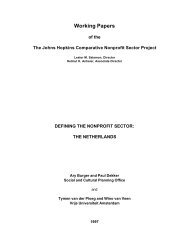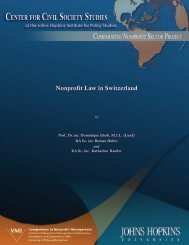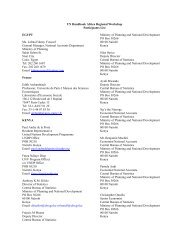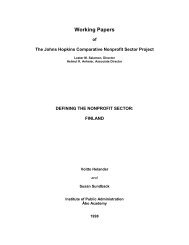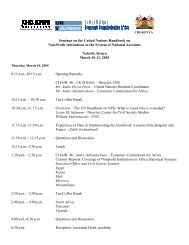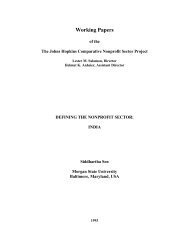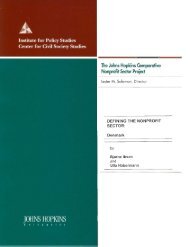DEFINING THE NONPROFIT SECTOR: ARGENTINA 1IntroductionThe presence of private nonprofit organizations in <strong>Argentina</strong> can be traced back to <strong>the</strong> turn of<strong>the</strong> 20 th century when <strong>the</strong> central state was consolidated, but also even before, to <strong>the</strong> colonial periodand <strong>the</strong> independence wars. In those times, many institutions dedicated to <strong>the</strong> public good werecreated in <strong>the</strong> social, political, and cultural fields, but mainly in <strong>the</strong> field of charity.However, <strong>the</strong> visibility of <strong>the</strong>se associations as a sector is relatively recent. Only in <strong>the</strong> lastdecade this sector has reached <strong>the</strong> public sphere under different denominations –e.g., nonprofitsector, third sector, voluntary sector– and has become an object of academic research. Never<strong>the</strong>less,several obstacles remain for achieving <strong>the</strong> visibility and streng<strong>the</strong>ning of <strong>the</strong> nonprofit sector: (a) <strong>the</strong>absence of quantitative information on <strong>the</strong> sector as a whole; (b) <strong>the</strong> overlap and heterogeneity bothof <strong>the</strong> terms and <strong>the</strong> legal norms referring to <strong>the</strong> different types of nonprofit organizations; and (c)<strong>the</strong> limited number of studies delving into <strong>the</strong> structure and development of <strong>the</strong> sector that take intoaccount <strong>the</strong> specific historical, cultural, and political features of <strong>Argentina</strong>.In this paper we outline <strong>the</strong> historical and structural characteristics of <strong>the</strong> Argentine nonprofitsector. To advance <strong>the</strong>se objectives, we first present a brief historical survey, reviewing some of <strong>the</strong>turning points and general tendencies in <strong>the</strong> development of voluntary institutions that will allow usto put into context <strong>the</strong> emergence and development of what recently has become <strong>the</strong> third sector. Webegin by reviewing <strong>the</strong> assistance services carried out by <strong>the</strong> Catholic Church, <strong>the</strong> charitableorganizations run by <strong>the</strong> upper classes, and <strong>the</strong> development of community organizations fostered by<strong>the</strong> immigrants that arrived in <strong>Argentina</strong> since <strong>the</strong> end of <strong>the</strong> 19 th century. Since <strong>the</strong> 1940s, <strong>the</strong>development of <strong>the</strong> welfare state and <strong>the</strong> massive extension of social rights are crucial facts tounderstand <strong>the</strong> evolution of <strong>the</strong> third sector. Ano<strong>the</strong>r relevant issue concerns <strong>the</strong> long period ofpolitical instability that began in 1955 and was marked by several coups d’etat, <strong>the</strong> extremepoliticization of society and <strong>the</strong> spread of political violence, and that culminated in 1976 with abloody military dictatorship. Throughout this period a general tendency seemed to prevail: <strong>the</strong>absence of a clear differentiation among <strong>the</strong> state, <strong>the</strong> market, and <strong>the</strong> civil society, or in o<strong>the</strong>r words,<strong>the</strong> continuous fusion –and confusion– between <strong>the</strong> private and public spheres.1Andrea Campetella, a sociologist, is a researcher at CEDES [Centro de Estudios de Estado y Sociedad (Center forResearch on <strong>the</strong> State and Society)]. Inés González Bombal, also a sociologist, is a researcher at CEDES,CONICET, and University of General Sarmiento. Mario Roitter, an economist, is a researcher at CEDES and LocalAssociate of <strong>the</strong> Johns Hopkins Comparative <strong>Nonprofit</strong> <strong>Sector</strong> Project. The research team at CEDES for <strong>the</strong> JohnsHopkins Project is composed by <strong>the</strong> authors, Daniel Gropper, an economist; and Candelaria Garay, a sociologist.1
Campetella, González Bombal, and Roitter<strong>Defining</strong> <strong>the</strong> <strong>Nonprofit</strong> <strong>Sector</strong>: <strong>Argentina</strong>In <strong>the</strong> 1980s, concurrent with <strong>the</strong> democratic transition, civil society organizations appearedas unquestionable actors both in a differentiated and even opposing position to public powers. Thistendency was evident in <strong>the</strong> decisive role played by human and civil rights organizations denouncingstate violence, and in <strong>the</strong> emergence of advocacy organizations promoting citizen participation and<strong>the</strong> control of public powers. Though it is still early to draw definite conclusions, a new periodseems to be opening up, marked by a more autonomous civil society within a stable political contextand <strong>the</strong> consolidation of democratic institutions. At <strong>the</strong> same time, <strong>the</strong> market has acquired greaterautonomy due to <strong>the</strong> structural reforms initiated in <strong>the</strong> 1990s, consisting of deregulation measuresintended to boost <strong>the</strong> liberal economy and accompanied by <strong>the</strong> withdrawal of <strong>the</strong> state from itswelfare functions.These tendencies towards a greater differentiation among <strong>the</strong> market, state, and civil societyplace <strong>Argentina</strong> in a stage of transition and allow a clearer view of nonprofit organizations as a sectorwith specific functions and characteristics. In <strong>the</strong> second section of this paper, we concentrate on <strong>the</strong>sector’s structure, examining <strong>the</strong> main types of organizations that comprise it. To this end we haveconsidered both <strong>the</strong> legal definition as well as <strong>the</strong> “social definition,” i.e., <strong>the</strong> different ways in which<strong>the</strong>se organizations are named and recognized in <strong>the</strong> public sphere. Such a distinction seemednecessary due to <strong>the</strong> fact that both dimensions, which do not always exhibit a similar structure, areimportant to understand idiosyncratic features of <strong>the</strong> Argentine third sector.Once a map of <strong>the</strong> sector has been drawn, in <strong>the</strong> third section we analyze it on <strong>the</strong> basis of <strong>the</strong>concepts developed by <strong>the</strong> Johns Hopkins Comparative <strong>Nonprofit</strong> <strong>Sector</strong> Project. First, we consider<strong>the</strong> structural-operational definition devised by Salamon and Anheier (1992) in <strong>the</strong> Argentinecontext. Second, we analyze <strong>the</strong> Argentine case in light of <strong>the</strong> <strong>the</strong>ory of social origins (Salamon andAnheier, 1996), which establishes four models resulting from <strong>the</strong> relationship between public socialspending, <strong>the</strong> dimension and scope of <strong>the</strong> third sector and a specific constellation of social forces.Finally, we conclude by highlighting <strong>the</strong> current transitional character of <strong>the</strong> Argentine case,which seems to be moving towards a model of greater autonomy among <strong>the</strong> spheres of market, stateand civil society, within <strong>the</strong> stable context of democracy.Historical AspectsThe origins of <strong>the</strong> nonprofit sector can be traced back to colonial times, when <strong>Argentina</strong> waspart of <strong>the</strong> viceroyalty of <strong>the</strong> Rio de la Plata, which belonged to <strong>the</strong> Spanish crown. The CatholicChurch played a crucial role in Spanish colonization, for both its influence on government and itscentrality to colonial social life. Thus, not only were <strong>the</strong> first initiatives of public good linked to <strong>the</strong>model of Christian charity, but also <strong>the</strong> first organizations engaged in such endeavors actuallysprouted from within <strong>the</strong> Catholic Church. Apart from <strong>the</strong> widespread activity undertaken byreligious orders –e.g., Jesuits, Dominicans, Franciscans– it is possible to distinguish severalinstitutions of public good 2 that exhibited relative independence from church authorities, stimulatedprimarily lay action, and were active mainly in <strong>the</strong> assistance field. The most important of <strong>the</strong>se2These institutions were mainly capellanías, confraternities and bro<strong>the</strong>rhoods. They helped to maintain <strong>the</strong> Catholiccult, founded monasteries and churches, took care of cemeteries, and assisted <strong>the</strong> poor and <strong>the</strong> needy.2
- Page 1 and 2: Working PapersofThe Johns Hopkins C
- Page 3: PREFACEThis is one in a series of W
- Page 7 and 8: Campetella, González Bombal, and R
- Page 9 and 10: Campetella, González Bombal, and R
- Page 11 and 12: Campetella, González Bombal, and R
- Page 13 and 14: Campetella, González Bombal, and R
- Page 15 and 16: Campetella, González Bombal, and R
- Page 17 and 18: Campetella, González Bombal, and R
- Page 19 and 20: Campetella, González Bombal, and R
- Page 21 and 22: Campetella, González Bombal, and R
- Page 23 and 24: Campetella, González Bombal, and R
- Page 25 and 26: Campetella, González Bombal, and R
- Page 27 and 28: Campetella, González Bombal, and R
- Page 29 and 30: Campetella, González Bombal, and R
- Page 31 and 32: Campetella, González Bombal, and R
- Page 33: Campetella, González Bombal, and R



